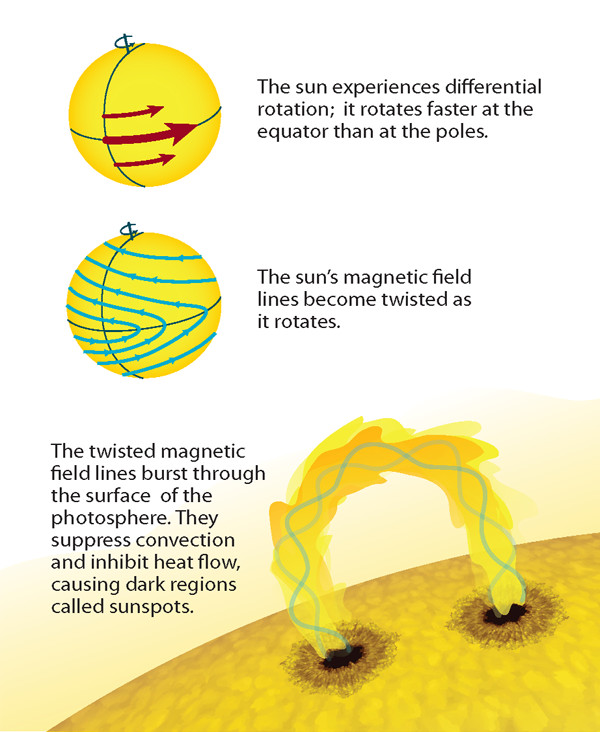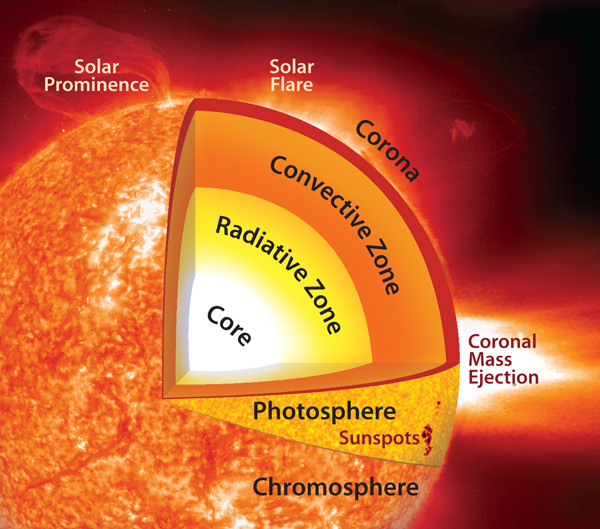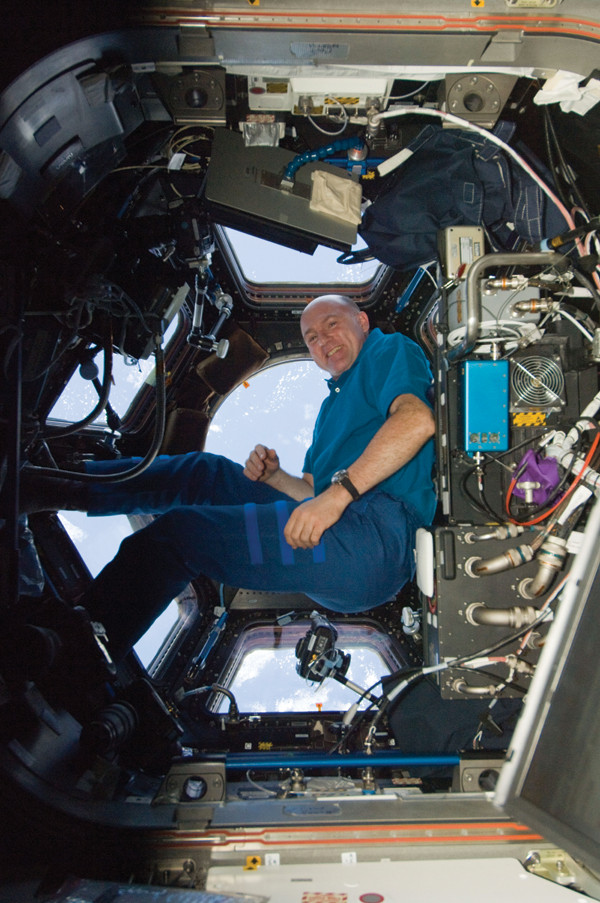
by Jay R. Thompson Monday, December 3, 2012

The creation of sunspots: Top: The sun experiences differential rotation; it rotates faster at the equator than at the poles. Middle: The sun's magnetic field lines become twisted as it rotates. Bottom: The twisted magnetic field lines burst through the surface of the photosphere. They suppress convection and inhibit heat flow, causing dark regions called sunspots. Kathleen Cantner, AGI

Solar structure. Kathleen Cantner, AGI

European Space Agency astronaut and flight engineer Andre Kuipers floats near a window aboard the International Space Station in January 2012. While Earth's atmosphere shields us from much of the hazardous radiation from solar flares, astronauts are protected only by the spacecraft or, if on a spacewalk, their spacesuits. NASA; photo by Will von Dauster
Sometime in the next few months — summer or fall of 2013, according to NASA’s Marshall Space Flight Center — the sun will reach the solar maximum, the peak of sunspot counts during its roughly 11-year cycle. Despite the sun’s seeming regularity, each solar cycle remains to some extent unpredictable. Although the average cycle lasts about 11 years, some are as long as 14 years or as brief as nine. Solar storms might be mild during a solar maximum or severe during a minimum.
As solar science continues to advance, researchers are finding new ways to study and forecast the behavior of our star, whose whims endanger our technology-dependent way of life. But what the upcoming peak means for solar storms, and how those storms will affect Earth, remain to be seen.
The sun’s cycle is marked from minimum to minimum, so the solar maximum occurs about halfway through the cycle. Scientists are not certain why the cycles consistently last about 11 years, but they do understand the mechanisms that cause solar activity like solar flares and coronal mass ejections (CMEs).
The sun’s magnetic field, like Earth’s, is generated from within by the flowing motion of material. But while Earth’s magnetic field is perpetuated by the churning of molten metal in the planet’s liquid outer core, the sun’s magnetic field is produced by the movement of plasma — a superheated state of matter in which electrons have been stripped from atoms, leaving a gas-like body of positive ions and free electrons.
Neither Earth’s nor the sun’s magnetic field is symmetric, stable or stationary. But the sun’s magnetic fields are more complex than Earth’s. Rather than one north and one south pole, the sun has many poles, with magnetic fields that constantly swell, bend and twist. A map of the sun’s magnetic structure at any given moment appears more like a tangled ball of yarn or a bunch of writhing snakes than the symmetrical toroid of textbook illustrations, and over an 11-year cycle, the sun’s whole magnetic structure flips. And it is that writhing and tangling that produces the solar activity that affects the rest of the solar system.
Solar activity has three basic ingredients: differential rotation, plasma and magnetic fields, says C. Alex Young, a solar astrophysicist and associate director of science for the Heliophysics Science Division at NASA’s Goddard Space Flight Center in Greenbelt, Md. Differential rotation means that the sun rotates at different speeds and directions at different latitudes and depths. That causes plasmas and magnetic fields to interact. “They get all twisted up inside,” Young says. “It’s like the rubber band on a balsa wood airplane — you twist the rubber band until it starts to knot up,” he says. But when the sun’s magnetic field lines get tangled up in knots, they become buoyant and pop to the surface where they produce sunspots, Young says.
A single sunspot has a magnetic strength thousands of times greater than Earth’s entire magnetic field, and enough influence to suppress heat and create surface regions where temperatures reach a mere 3,700 kelvins, 2,000 kelvins cooler than the surrounding surface.
Visibly darker than the rest of the sun, a sunspot can last days or weeks. But the magnetic field lines that cause sunspots don’t want to stay tangled. When the lines get twisted up, “the magnetic field gets really unstable and so it reconfigures itself and releases energy — the rubber band snaps,” Young says. That release of energy can produce light in the form of a solar flare, or it can produce a CME, or both a flare and a CME.
Although the terms solar flare and CME are often used interchangeably, they’re not the same thing. “Basically, a solar flare is a brief flash of electromagnetic radiation — from radio waves to gamma rays, the entire electromagnetic spectrum — and a CME is roughly a billion tons of solar plasma and a magnetic field,” Young says. That’s why solar physicists often refer to a CME as a magnetic cloud. “It’s a big blob of plasma,” he says, that travels between 1.5 million and 8 million kilometers per hour and, if ejected in our direction, typically reaches Earth in two or three days.
The largest CME known to have hit Earth, called the Carrington Event, allowed researchers to realize the connection between solar activity and Earth’s geomagnetic field (see sidebar). That CME, which occurred in 1859, disrupted what little electrical technology was used at the time, perhaps most notably the telegraph system. But much smaller events have since impacted the modern world. In 1972, a CME caused a geomagnetic storm that took out phone lines in Illinois. An event in 1989 melted power transformers in New Jersey and knocked out power for most of Quebec, leaving 6 million people without electricity for about half a day. In 2003, the Great Halloween Storms knocked out power in some places and shut down some satellites. And in 2006, radio noise from a solar blast interrupted satellite communications with surface stations and disrupted the Global Positioning System (GPS) for 10 minutes.
When CMEs interact with Earth’s magnetic field, they can wreak havoc on our technologies. So scientists keep a close eye on such activity.
A variety of satellites, including NASA’s SOHO (SOlar and Heliospheric Observatory), STEREO (Solar TErrestrial RElations Observatory) and SDO (Solar Dynamics Observatory), and ground-based observatories stare at the sun 24 hours a day, monitoring solar activity as it happens. Within about a half hour of a CME tearing away from the sun, scientists not only know that it happened, but also which direction it’s going and how fast, says Joe Kunches, a space scientist at NOAA’s Space Weather Prediction Center in Boulder, Colo.
“We get information within three seconds of when the satellites measure it,” Kunches says. However, scientists don’t know for sure that the CME is headed toward Earth, or how intense it’s going to be, until it hits the Advanced Composition Explorer, or ACE, satellite. The ACE satellite was launched in 1997 and sits at a point of Earth-sun gravitational equilibrium, known as a Lagrangian (or libration) point, about 1.5 million kilometers from home. It is equipped with nine sensors and instruments to study magnetic fields, solar wind and particles accelerated by solar activity and other means.
“ACE is our early-warning system,” Young says. Depending on the speed of a CME, the ACE satellite can provide 20 to 60 minutes of warning before impact, enough to allow spacewalking astronauts to return to the relative safety of their spacecraft or to warn power grid operators that their systems may soon be overloaded.
Solar flares are another story. They travel at the speed of light because they are, technically, light — electromagnetic radiation — so when we see a solar flare, it’s already here.
Since 1975, the Geostationary Operational Environmental Satellites (GOES) have orbited Earth, observing weather and monitoring X-rays, a telltale sign of a solar flare. A solar flare releases an amount of energy equivalent to millions of hydrogen bombs going off at the same time, and even millions of kilometers away from the sun, those X-rays are strong enough to endanger spacewalking astronauts. Though GOES can’t protect astronauts by providing warning of solar flares, the satellites do contribute to the understanding of the sun’s most explosive behavior.
While science’s tools to observe and study solar activity are ever improving, scientists still don’t know when solar flares or CMEs will occur until they already have. A prime example of the challenge of forecasting solar activity is the 2003 Great Halloween Storms, which occurred a couple of years after the last solar maximum, when the sun seemed to be quieting down. Over a three-week period starting in mid-October, 17 major flares and CMEs erupted. People reported seeing auroras as far south as Florida. Meanwhile, air traffic controllers rerouted flights, parts of Sweden lost power, and even some of the satellites whose sole purpose was to observe solar activity failed temporarily or were damaged.
Typically, a CME takes two or three days to get from the sun to Earth, Kunches says. But one CME from the Halloween Storms reached Earth in just 19 hours, he says.
The Halloween Storms were a surprising burst of activity, but the sun can defy its cycle in the opposite direction as well. From the mid-17th century to the early 18th century, sunspot activity dropped off the charts in a period now called the Maunder Minimum. “There were basically no sunspots for 70 years,” Kunches says. Scientists don’t know why this occurred, he says, nor do they know when it might happen again. In fact, he adds, “some scientists think we’re about to enter one of those periods.”
In an effort to forecast solar activity and the space weather that results, solar physicists have focused on the sun’s interior, where heat and turbulence cause pressure changes, creating sound waves that travel through the sun’s interior. This phenomenon causes waves on the surface of the sun, the study of which — called helioseismology — can provide researchers with rudimentary forecasts for solar activity.
“But we don’t have any way of predicting what’s going to happen,” says Jere Jenkins, a nuclear engineer at Purdue University who is working on a way to predict solar activity half a day before it happens by monitoring something on Earth: the rate at which radioactive elements decay. Jenkins and Ephraim Fischbach, a Purdue physics professor, have proposed a controversial hypothesis that neutrinos from the sun are interacting with, and changing, the decay rates of radioactive elements in ways that are consistent and detectable enough to predict solar storms. “Each second, about 60 billion solar neutrinos pass through your thumbnail — about 1 square centimeter — but in your lifetime, only one will stop within your body,” Jenkins says. “So there are a lot of them, but they don’t really interact with anything in the ‘standard’ way.”
In the mid-2000s, Jenkins and Fischbach were studying the statistical randomness of radioactive decay when they noticed a periodicity in changes to the decay rate. The decay rate dropped in January, when Earth is closest to the sun. After ruling out other variables and finding similar periodicities in the literature, they wondered if it might be the influence of the sun.
Then, in late 2006, a solar flare during the solar minimum caught everyone by surprise, including astronauts at the International Space Station who were on a spacewalk when the flare erupted.
Using data from GOES to pinpoint the time of the flare, the pair discovered a minimum in radioactive decay on Earth that coincided with the maximum activity picked up by the satellite. They also found something that was perhaps even more important. “We started seeing a change in the decay rate between 39 and 40 hours before the flare,” Jenkins says.
About a dozen studies have since been published supporting the hypothesis that something happening at the sun is influencing the rate of radioactive decay prior to observed solar flares, and researchers have observed 10 more solar flares since 2006 with results more or less in line with Jenkins and Fischbach’s findings. But the hypothesis remains controversial because it runs contrary to established paradigms.
More than 80 years ago, English physicist Ernest Rutherford declared that radioactive decay rates are constant, meaning outside forces shouldn’t have any effect on the rate. Additionally, solar neutrinos aren’t thought to interact with much of anything. So those are “two paradigms we’re challenging,” Jenkins says.
Despite the strong pushback from some particle physicists, nuclear physicists and others, Jenkins and Fischbach are moving ahead with attempts to develop a forecasting service based on radioisotope monitoring, which, Jenkins says, could provide government agencies and corporations with 12 to 18 hours of warning before a solar flare or CME erupts. Power grids, satellites, aircraft, astronauts, oceangoing ships and others could then temporarily shut down, re-route, or pause in anticipation of a solar flare or CME.
Without such warning, “a Carrington Event would wipe it all out,” Jenkins says. “We’d be back to technology circa 1930,” he says.
In an upcoming issue, EARTH Magazine will address space weather policy issues, from the vulnerability of the U.S. power grid and satellites, to mitigating the impact of solar events, as well as how a Carrington Event would impact daily life in this technologically advanced era.
© 2008-2021. All rights reserved. Any copying, redistribution or retransmission of any of the contents of this service without the expressed written permission of the American Geosciences Institute is expressly prohibited. Click here for all copyright requests.